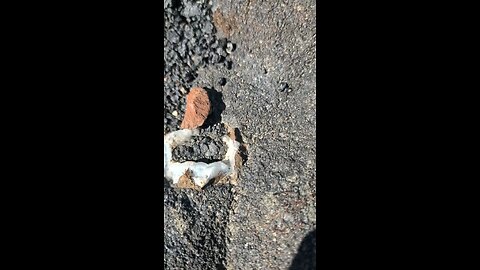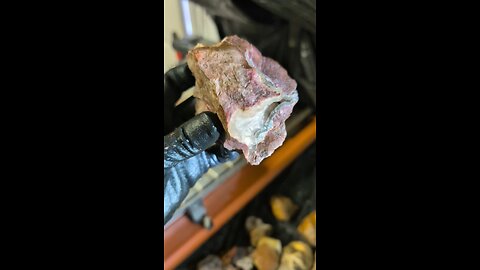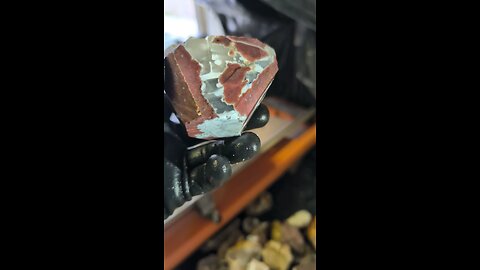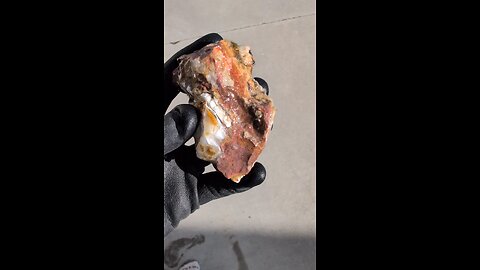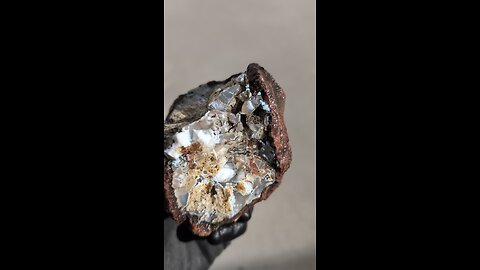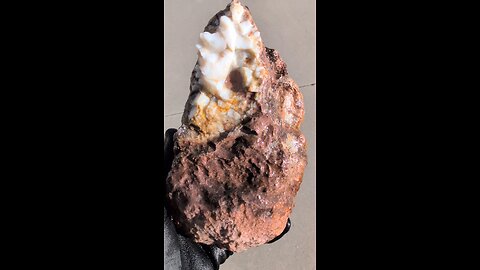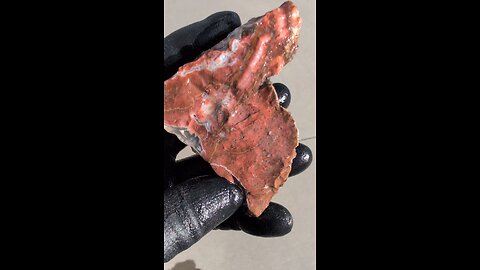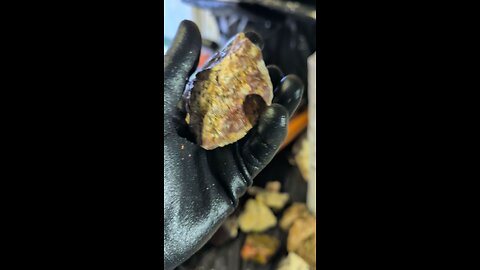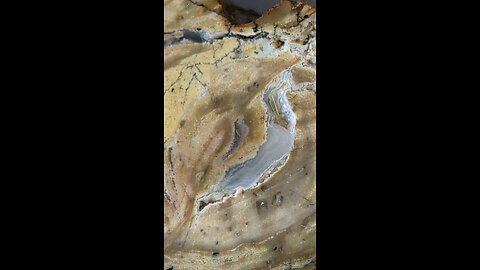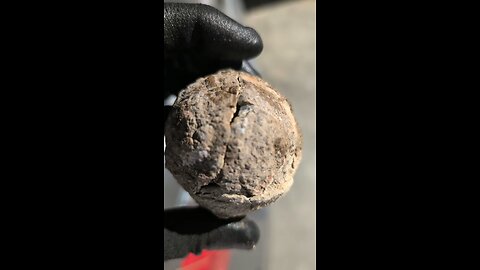
Thundereggs!
60 videos
Updated 1 month ago
Thundereggs are unique geological formations often confused with geodes or agates due to some similarities, but they possess distinct characteristics. Here's an in-depth look at thundereggs:
Formation:
Volcanic Origin: Thundereggs form within layers of rhyolitic volcanic ash or lava flows. They begin as gas bubbles or voids in the cooling lava, acting as molds.
Mineral Deposition: Over millions of years, groundwater rich in silica percolates through these porous volcanic rocks. The silica precipitates out of solution, filling these cavities. This process can be cyclical, with different events leading to varied mineral compositions and patterns within the thunderegg.
Slow Crystallization: The minerals crystallize slowly, often forming concentric layers of chalcedony, agate, jasper, or opal, sometimes with quartz or calcite crystals in the center.
Characteristics:
Shape: Generally spherical or ovoid, ranging from a few centimeters to over a meter in diameter, though most are about the size of a baseball.
Exterior: Typically, thundereggs have a rough, bumpy, and unremarkable exterior, often appearing as ordinary rocks until cut open.
Interior: When cut and polished, they reveal intricate patterns, colors, and sometimes landscapes of agate, jasper, or other minerals. Unlike geodes, thundereggs may not be hollow; they are usually filled or have only small cavities.
Composition: The core can consist of various minerals, leading to a wide variety of appearances. The outer shell is generally rhyolite or a similar volcanic rock.
Locations:
Oregon, USA: Particularly famous for thundereggs, especially in areas like the Owyhee Canyonlands, Ochoco National Forest, and near Prineville, where it's even the state rock.
Other Regions: They are also found in places like Germany, Mexico, Australia, and Brazil, but Oregon remains the most renowned source.
Cultural and Historical Aspects:
Naming: The name "thunderegg" reportedly comes from Native American legends where these formations were believed to be the eggs of thunderbirds, mythical creatures associated with storms and thunder.
Collection: Thundereggs are highly sought after by rock collectors, lapidaries, and enthusiasts for their unique beauty when cut and polished.
Uses:
Jewelry and Art: When cut and polished, the colorful and patterned interiors are used for cabochons, beads, and decorative art pieces.
Decorative: Larger specimens are used as display pieces or in home decor.
Educational: They provide insights into geological processes and are used in educational settings to teach about mineralogy and volcanology.
Considerations:
Variability: Each thunderegg can be quite different, even from the same bed, making them unpredictable and exciting to collect.
Cutting and Polishing: To reveal their beauty, thundereggs must be cut, which requires special equipment like a rock saw and polisher.
Ethical Collecting: Due to their popularity, collectors should be aware of legal regulations regarding collecting, especially on public lands or private property.
Thundereggs are not only a marvel of natural geology but also a testament to the complex interplay between volcanic activity and subsequent mineral deposition, offering both scientific value and aesthetic pleasure.
-
Whole & Broken Geodes!
 RyanzRocksA geode is a hollow, usually spherical rock, that when broken open reveals a cavity lined with crystals or other mineral formations. Here are some key points about geodes: Formation: Geodes form when gas bubbles or cavities in volcanic or sedimentary rock are filled with mineral-rich water. As the water evaporates, it leaves behind minerals which crystallize over time, lining the inside of the cavity. Structure: The outer layer of a geode is typically rough and nondescript, often making it look like an ordinary rock until it's cracked open. Inside, you might find crystals like quartz, amethyst, calcite, or even rarer minerals. Location: They are commonly found in regions with volcanic activity or limestone deposits. Famous locations include parts of the United States, Brazil, Uruguay, and Mexico. Uses: Geodes are popular among rock collectors and are often cut and polished for use in jewelry or as decorative pieces. Some are also used in metaphysical practices for their supposed healing properties. Identification: To identify a geode, one would typically look for a rock that is unusually light for its size or has a hollow sound when tapped. However, the only definitive way to confirm is by breaking it open or using specialized equipment like X-rays. If you're interested in finding or identifying geodes, or if you have any other questions about them, feel free to ask!Rabbit Springs Geode Field, is a well-known rockhounding site located in southern Idaho near the Nevada border. It’s a popular spot for collectors seeking thundereggs—spherical rocks that often contain beautiful agate or crystal-filled centers, some of which fluoresce under UV light due to mineral content like chalcedony or quartz.67 views
RyanzRocksA geode is a hollow, usually spherical rock, that when broken open reveals a cavity lined with crystals or other mineral formations. Here are some key points about geodes: Formation: Geodes form when gas bubbles or cavities in volcanic or sedimentary rock are filled with mineral-rich water. As the water evaporates, it leaves behind minerals which crystallize over time, lining the inside of the cavity. Structure: The outer layer of a geode is typically rough and nondescript, often making it look like an ordinary rock until it's cracked open. Inside, you might find crystals like quartz, amethyst, calcite, or even rarer minerals. Location: They are commonly found in regions with volcanic activity or limestone deposits. Famous locations include parts of the United States, Brazil, Uruguay, and Mexico. Uses: Geodes are popular among rock collectors and are often cut and polished for use in jewelry or as decorative pieces. Some are also used in metaphysical practices for their supposed healing properties. Identification: To identify a geode, one would typically look for a rock that is unusually light for its size or has a hollow sound when tapped. However, the only definitive way to confirm is by breaking it open or using specialized equipment like X-rays. If you're interested in finding or identifying geodes, or if you have any other questions about them, feel free to ask!Rabbit Springs Geode Field, is a well-known rockhounding site located in southern Idaho near the Nevada border. It’s a popular spot for collectors seeking thundereggs—spherical rocks that often contain beautiful agate or crystal-filled centers, some of which fluoresce under UV light due to mineral content like chalcedony or quartz.67 views -
Geode Field!
 RyanzRocksRabbit Springs Geode Field, also known as Rabbit Springs Thundereggs, is a well-known rockhounding site located in southern Idaho near the Nevada border. It’s a popular spot for collectors seeking thundereggs—spherical rocks that often contain beautiful agate or crystal-filled centers, some of which fluoresce under UV light due to mineral content like chalcedony or quartz. This site sits along U.S. Highway 93, roughly 38 miles from Twin Falls, Idaho, and about 130 miles from Mountain Home, making it accessible yet remote enough to feel like a true adventure. The coordinates for Rabbit Springs are approximately 42.06572°N, -114.67387°W. You can get there by driving south from Twin Falls toward Jackpot, Nevada, and looking for the old Rabbit Springs rest area, a historical marker for the site. The terrain is rugged, typical of the high desert landscape in this region, with volcanic and sedimentary rocks from ancient geological activity providing the perfect conditions for thunderegg formation. These rocks are remnants of gas pockets in lava flows that filled with silica-rich fluids over millions of years. No heavy digging is necessary here—surface collecting with a bucket is the way to go, as many thundereggs are weathered out and scattered across the ground. A rock hammer might come in handy to crack them open, but locals and seasoned rockhounds suggest the best finds are often already exposed, and breaking into the bedrock isn’t worth the effort. The thundereggs vary in size, from plums to grapefruits, and some glow a striking green or orange under a 365nm UV light, thanks to trace minerals. Rumors of radioactivity have floated around, but tests with Geiger counters have debunked that myth. The site is on public land managed by the Bureau of Land Management (BLM), so casual collecting is allowed as long as you’re not using heavy machinery or digging extensive tunnels—stick to hand tools and surface finds. Any vehicle can make the trip, though the final approach might involve a short walk from the highway. September’s cooler weather makes it an ideal time to visit, avoiding the summer heat of this arid region.43 views
RyanzRocksRabbit Springs Geode Field, also known as Rabbit Springs Thundereggs, is a well-known rockhounding site located in southern Idaho near the Nevada border. It’s a popular spot for collectors seeking thundereggs—spherical rocks that often contain beautiful agate or crystal-filled centers, some of which fluoresce under UV light due to mineral content like chalcedony or quartz. This site sits along U.S. Highway 93, roughly 38 miles from Twin Falls, Idaho, and about 130 miles from Mountain Home, making it accessible yet remote enough to feel like a true adventure. The coordinates for Rabbit Springs are approximately 42.06572°N, -114.67387°W. You can get there by driving south from Twin Falls toward Jackpot, Nevada, and looking for the old Rabbit Springs rest area, a historical marker for the site. The terrain is rugged, typical of the high desert landscape in this region, with volcanic and sedimentary rocks from ancient geological activity providing the perfect conditions for thunderegg formation. These rocks are remnants of gas pockets in lava flows that filled with silica-rich fluids over millions of years. No heavy digging is necessary here—surface collecting with a bucket is the way to go, as many thundereggs are weathered out and scattered across the ground. A rock hammer might come in handy to crack them open, but locals and seasoned rockhounds suggest the best finds are often already exposed, and breaking into the bedrock isn’t worth the effort. The thundereggs vary in size, from plums to grapefruits, and some glow a striking green or orange under a 365nm UV light, thanks to trace minerals. Rumors of radioactivity have floated around, but tests with Geiger counters have debunked that myth. The site is on public land managed by the Bureau of Land Management (BLM), so casual collecting is allowed as long as you’re not using heavy machinery or digging extensive tunnels—stick to hand tools and surface finds. Any vehicle can make the trip, though the final approach might involve a short walk from the highway. September’s cooler weather makes it an ideal time to visit, avoiding the summer heat of this arid region.43 views -
Botryoidal cut!
 RyanzRocksBotryoidal is a term used in mineralogy to describe a mineral or rock formation that has a rounded, grape-like, or botryoidal (from the Greek word "botryoeidēs" meaning "like a bunch of grapes") shape. Here are some key points about botryoidal formations: Formation: Botryoidal structures form when minerals precipitate from solution in a way that creates rounded, nodular surfaces. This often happens in cavities or vugs within rocks where mineral-rich solutions slowly deposit layers of minerals, building up in a manner that mimics the shape of grapes. Common Minerals: Some minerals commonly found in botryoidal forms include: Hematite: Often forms botryoidal shapes with a metallic luster. Malachite: Known for its vibrant green botryoidal formations. Goethite: Can exhibit botryoidal textures, usually in brown or yellow hues. Chalcedony: Including varieties like agate, which can form botryoidal layers within geodes. Psilomelane: A manganese oxide mineral often found in botryoidal shapes. Texture: The texture of botryoidal minerals is smooth and rounded, with a surface that looks like clusters of small spheres or nodules. This texture is due to the slow, even deposition of mineral material from solution. Uses: Jewelry and Decoration: Botryoidal minerals are prized for their unique shapes and are often polished or cut into cabochons for use in jewelry. They can also be used as decorative stones. Collectors: Due to their distinctive appearance, botryoidal specimens are popular among mineral collectors. Art: Their natural beauty makes them suitable for artistic endeavors, including sculptures or inlays. Geological Significance: Botryoidal formations can provide insights into the conditions under which the minerals precipitated, often indicating slow, stable conditions conducive to this type of growth. They are also indicators of the fluid dynamics and chemistry in the environment where they formed.47 views
RyanzRocksBotryoidal is a term used in mineralogy to describe a mineral or rock formation that has a rounded, grape-like, or botryoidal (from the Greek word "botryoeidēs" meaning "like a bunch of grapes") shape. Here are some key points about botryoidal formations: Formation: Botryoidal structures form when minerals precipitate from solution in a way that creates rounded, nodular surfaces. This often happens in cavities or vugs within rocks where mineral-rich solutions slowly deposit layers of minerals, building up in a manner that mimics the shape of grapes. Common Minerals: Some minerals commonly found in botryoidal forms include: Hematite: Often forms botryoidal shapes with a metallic luster. Malachite: Known for its vibrant green botryoidal formations. Goethite: Can exhibit botryoidal textures, usually in brown or yellow hues. Chalcedony: Including varieties like agate, which can form botryoidal layers within geodes. Psilomelane: A manganese oxide mineral often found in botryoidal shapes. Texture: The texture of botryoidal minerals is smooth and rounded, with a surface that looks like clusters of small spheres or nodules. This texture is due to the slow, even deposition of mineral material from solution. Uses: Jewelry and Decoration: Botryoidal minerals are prized for their unique shapes and are often polished or cut into cabochons for use in jewelry. They can also be used as decorative stones. Collectors: Due to their distinctive appearance, botryoidal specimens are popular among mineral collectors. Art: Their natural beauty makes them suitable for artistic endeavors, including sculptures or inlays. Geological Significance: Botryoidal formations can provide insights into the conditions under which the minerals precipitated, often indicating slow, stable conditions conducive to this type of growth. They are also indicators of the fluid dynamics and chemistry in the environment where they formed.47 views -
Shaping!
 RyanzRocksA Thunderegg is a geological structure similar to a geode but with unique characteristics. Here's an overview: Formation: Thundereggs form within rhyolitic volcanic ash layers. They start as gas bubbles or steam pockets in the lava, which act as molds. Over time, these are filled with silica-rich fluids, mainly chalcedony, agate, jasper, or opal, creating intricate patterns and colors inside. Appearance: On the outside, thundereggs look like ordinary, rough-textured rocks, often with a white-gray to reddish-brown surface. However, when cut and polished, they reveal a variety of internal structures, from solid agate or chalcedony cores to sometimes hollow centers with crystals. Size: They can range from small, about the size of a baseball, to larger specimens over a meter across, though most commonly they are between two to six inches in diameter. Locations: While Oregon, USA, is particularly famous for thundereggs, especially in counties like Crook, Jefferson, Malheur, Wasco, and Wheeler, they are found globally wherever the geological conditions are right. Other notable locations include Germany, Australia, Brazil, Canada, Mexico, Poland, Romania, and Turkey. Cultural Significance: In Oregon, the thunderegg was designated as the state rock in 1965, reflecting its importance in local geology and culture. Native American legends attribute their formation to thunder spirits or gods throwing these rocks during thunderstorms. Collection and Use: Thundereggs are popular among rock collectors for their unique beauty once cut open. They're often used in jewelry making or as display pieces due to their aesthetic appeal after being sliced and polished. Variations: Each thunderegg is unique due to the minerals present in the area where it forms, leading to a wide variety in color, pattern, and structure even from the same bed.58 views
RyanzRocksA Thunderegg is a geological structure similar to a geode but with unique characteristics. Here's an overview: Formation: Thundereggs form within rhyolitic volcanic ash layers. They start as gas bubbles or steam pockets in the lava, which act as molds. Over time, these are filled with silica-rich fluids, mainly chalcedony, agate, jasper, or opal, creating intricate patterns and colors inside. Appearance: On the outside, thundereggs look like ordinary, rough-textured rocks, often with a white-gray to reddish-brown surface. However, when cut and polished, they reveal a variety of internal structures, from solid agate or chalcedony cores to sometimes hollow centers with crystals. Size: They can range from small, about the size of a baseball, to larger specimens over a meter across, though most commonly they are between two to six inches in diameter. Locations: While Oregon, USA, is particularly famous for thundereggs, especially in counties like Crook, Jefferson, Malheur, Wasco, and Wheeler, they are found globally wherever the geological conditions are right. Other notable locations include Germany, Australia, Brazil, Canada, Mexico, Poland, Romania, and Turkey. Cultural Significance: In Oregon, the thunderegg was designated as the state rock in 1965, reflecting its importance in local geology and culture. Native American legends attribute their formation to thunder spirits or gods throwing these rocks during thunderstorms. Collection and Use: Thundereggs are popular among rock collectors for their unique beauty once cut open. They're often used in jewelry making or as display pieces due to their aesthetic appeal after being sliced and polished. Variations: Each thunderegg is unique due to the minerals present in the area where it forms, leading to a wide variety in color, pattern, and structure even from the same bed.58 views -
Broken Thunderegg Cluster!
 RyanzRocksA Thunderegg is a geological structure similar to a geode but with unique characteristics. Here's an overview: Formation: Thundereggs form within rhyolitic volcanic ash layers. They start as gas bubbles or steam pockets in the lava, which act as molds. Over time, these are filled with silica-rich fluids, mainly chalcedony, agate, jasper, or opal, creating intricate patterns and colors inside. Appearance: On the outside, thundereggs look like ordinary, rough-textured rocks, often with a white-gray to reddish-brown surface. However, when cut and polished, they reveal a variety of internal structures, from solid agate or chalcedony cores to sometimes hollow centers with crystals. Size: They can range from small, about the size of a baseball, to larger specimens over a meter across, though most commonly they are between two to six inches in diameter. Locations: While Oregon, USA, is particularly famous for thundereggs, especially in counties like Crook, Jefferson, Malheur, Wasco, and Wheeler, they are found globally wherever the geological conditions are right. Other notable locations include Germany, Australia, Brazil, Canada, Mexico, Poland, Romania, and Turkey. Cultural Significance: In Oregon, the thunderegg was designated as the state rock in 1965, reflecting its importance in local geology and culture. Native American legends attribute their formation to thunder spirits or gods throwing these rocks during thunderstorms. Collection and Use: Thundereggs are popular among rock collectors for their unique beauty once cut open. They're often used in jewelry making or as display pieces due to their aesthetic appeal after being sliced and polished. Variations: Each thunderegg is unique due to the minerals present in the area where it forms, leading to a wide variety in color, pattern, and structure even from the same bed.64 views
RyanzRocksA Thunderegg is a geological structure similar to a geode but with unique characteristics. Here's an overview: Formation: Thundereggs form within rhyolitic volcanic ash layers. They start as gas bubbles or steam pockets in the lava, which act as molds. Over time, these are filled with silica-rich fluids, mainly chalcedony, agate, jasper, or opal, creating intricate patterns and colors inside. Appearance: On the outside, thundereggs look like ordinary, rough-textured rocks, often with a white-gray to reddish-brown surface. However, when cut and polished, they reveal a variety of internal structures, from solid agate or chalcedony cores to sometimes hollow centers with crystals. Size: They can range from small, about the size of a baseball, to larger specimens over a meter across, though most commonly they are between two to six inches in diameter. Locations: While Oregon, USA, is particularly famous for thundereggs, especially in counties like Crook, Jefferson, Malheur, Wasco, and Wheeler, they are found globally wherever the geological conditions are right. Other notable locations include Germany, Australia, Brazil, Canada, Mexico, Poland, Romania, and Turkey. Cultural Significance: In Oregon, the thunderegg was designated as the state rock in 1965, reflecting its importance in local geology and culture. Native American legends attribute their formation to thunder spirits or gods throwing these rocks during thunderstorms. Collection and Use: Thundereggs are popular among rock collectors for their unique beauty once cut open. They're often used in jewelry making or as display pieces due to their aesthetic appeal after being sliced and polished. Variations: Each thunderegg is unique due to the minerals present in the area where it forms, leading to a wide variety in color, pattern, and structure even from the same bed.64 views -
Half a thunderegg!
 RyanzRocksA Thunderegg is a geological structure similar to a geode but with unique characteristics. Here's an overview: Formation: Thundereggs form within rhyolitic volcanic ash layers. They start as gas bubbles or steam pockets in the lava, which act as molds. Over time, these are filled with silica-rich fluids, mainly chalcedony, agate, jasper, or opal, creating intricate patterns and colors inside. Appearance: On the outside, thundereggs look like ordinary, rough-textured rocks, often with a white-gray to reddish-brown surface. However, when cut and polished, they reveal a variety of internal structures, from solid agate or chalcedony cores to sometimes hollow centers with crystals. Size: They can range from small, about the size of a baseball, to larger specimens over a meter across, though most commonly they are between two to six inches in diameter. Locations: While Oregon, USA, is particularly famous for thundereggs, especially in counties like Crook, Jefferson, Malheur, Wasco, and Wheeler, they are found globally wherever the geological conditions are right. Other notable locations include Germany, Australia, Brazil, Canada, Mexico, Poland, Romania, and Turkey. Cultural Significance: In Oregon, the thunderegg was designated as the state rock in 1965, reflecting its importance in local geology and culture. Native American legends attribute their formation to thunder spirits or gods throwing these rocks during thunderstorms. Collection and Use: Thundereggs are popular among rock collectors for their unique beauty once cut open. They're often used in jewelry making or as display pieces due to their aesthetic appeal after being sliced and polished. Variations: Each thunderegg is unique due to the minerals present in the area where it forms, leading to a wide variety in color, pattern, and structure even from the same bed.58 views
RyanzRocksA Thunderegg is a geological structure similar to a geode but with unique characteristics. Here's an overview: Formation: Thundereggs form within rhyolitic volcanic ash layers. They start as gas bubbles or steam pockets in the lava, which act as molds. Over time, these are filled with silica-rich fluids, mainly chalcedony, agate, jasper, or opal, creating intricate patterns and colors inside. Appearance: On the outside, thundereggs look like ordinary, rough-textured rocks, often with a white-gray to reddish-brown surface. However, when cut and polished, they reveal a variety of internal structures, from solid agate or chalcedony cores to sometimes hollow centers with crystals. Size: They can range from small, about the size of a baseball, to larger specimens over a meter across, though most commonly they are between two to six inches in diameter. Locations: While Oregon, USA, is particularly famous for thundereggs, especially in counties like Crook, Jefferson, Malheur, Wasco, and Wheeler, they are found globally wherever the geological conditions are right. Other notable locations include Germany, Australia, Brazil, Canada, Mexico, Poland, Romania, and Turkey. Cultural Significance: In Oregon, the thunderegg was designated as the state rock in 1965, reflecting its importance in local geology and culture. Native American legends attribute their formation to thunder spirits or gods throwing these rocks during thunderstorms. Collection and Use: Thundereggs are popular among rock collectors for their unique beauty once cut open. They're often used in jewelry making or as display pieces due to their aesthetic appeal after being sliced and polished. Variations: Each thunderegg is unique due to the minerals present in the area where it forms, leading to a wide variety in color, pattern, and structure even from the same bed.58 views -
Thunderegg Cluster w Common Opal!
 RyanzRocksA Thunderegg is a geological structure similar to a geode but with unique characteristics. Here's an overview: Formation: Thundereggs form within rhyolitic volcanic ash layers. They start as gas bubbles or steam pockets in the lava, which act as molds. Over time, these are filled with silica-rich fluids, mainly chalcedony, agate, jasper, or opal, creating intricate patterns and colors inside. Appearance: On the outside, thundereggs look like ordinary, rough-textured rocks, often with a white-gray to reddish-brown surface. However, when cut and polished, they reveal a variety of internal structures, from solid agate or chalcedony cores to sometimes hollow centers with crystals. Size: They can range from small, about the size of a baseball, to larger specimens over a meter across, though most commonly they are between two to six inches in diameter. Locations: While Oregon, USA, is particularly famous for thundereggs, especially in counties like Crook, Jefferson, Malheur, Wasco, and Wheeler, they are found globally wherever the geological conditions are right. Other notable locations include Germany, Australia, Brazil, Canada, Mexico, Poland, Romania, and Turkey. Cultural Significance: In Oregon, the thunderegg was designated as the state rock in 1965, reflecting its importance in local geology and culture. Native American legends attribute their formation to thunder spirits or gods throwing these rocks during thunderstorms. Collection and Use: Thundereggs are popular among rock collectors for their unique beauty once cut open. They're often used in jewelry making or as display pieces due to their aesthetic appeal after being sliced and polished. Variations: Each thunderegg is unique due to the minerals present in the area where it forms, leading to a wide variety in color, pattern, and structure even from the same bed.66 views
RyanzRocksA Thunderegg is a geological structure similar to a geode but with unique characteristics. Here's an overview: Formation: Thundereggs form within rhyolitic volcanic ash layers. They start as gas bubbles or steam pockets in the lava, which act as molds. Over time, these are filled with silica-rich fluids, mainly chalcedony, agate, jasper, or opal, creating intricate patterns and colors inside. Appearance: On the outside, thundereggs look like ordinary, rough-textured rocks, often with a white-gray to reddish-brown surface. However, when cut and polished, they reveal a variety of internal structures, from solid agate or chalcedony cores to sometimes hollow centers with crystals. Size: They can range from small, about the size of a baseball, to larger specimens over a meter across, though most commonly they are between two to six inches in diameter. Locations: While Oregon, USA, is particularly famous for thundereggs, especially in counties like Crook, Jefferson, Malheur, Wasco, and Wheeler, they are found globally wherever the geological conditions are right. Other notable locations include Germany, Australia, Brazil, Canada, Mexico, Poland, Romania, and Turkey. Cultural Significance: In Oregon, the thunderegg was designated as the state rock in 1965, reflecting its importance in local geology and culture. Native American legends attribute their formation to thunder spirits or gods throwing these rocks during thunderstorms. Collection and Use: Thundereggs are popular among rock collectors for their unique beauty once cut open. They're often used in jewelry making or as display pieces due to their aesthetic appeal after being sliced and polished. Variations: Each thunderegg is unique due to the minerals present in the area where it forms, leading to a wide variety in color, pattern, and structure even from the same bed.66 views -
Red Thunderegg Shard!
 RyanzRocksA Thunderegg is a geological structure similar to a geode but with unique characteristics. Here's an overview: Formation: Thundereggs form within rhyolitic volcanic ash layers. They start as gas bubbles or steam pockets in the lava, which act as molds. Over time, these are filled with silica-rich fluids, mainly chalcedony, agate, jasper, or opal, creating intricate patterns and colors inside. Appearance: On the outside, thundereggs look like ordinary, rough-textured rocks, often with a white-gray to reddish-brown surface. However, when cut and polished, they reveal a variety of internal structures, from solid agate or chalcedony cores to sometimes hollow centers with crystals. Size: They can range from small, about the size of a baseball, to larger specimens over a meter across, though most commonly they are between two to six inches in diameter. Locations: While Oregon, USA, is particularly famous for thundereggs, especially in counties like Crook, Jefferson, Malheur, Wasco, and Wheeler, they are found globally wherever the geological conditions are right. Other notable locations include Germany, Australia, Brazil, Canada, Mexico, Poland, Romania, and Turkey. Cultural Significance: In Oregon, the thunderegg was designated as the state rock in 1965, reflecting its importance in local geology and culture. Native American legends attribute their formation to thunder spirits or gods throwing these rocks during thunderstorms. Collection and Use: Thundereggs are popular among rock collectors for their unique beauty once cut open. They're often used in jewelry making or as display pieces due to their aesthetic appeal after being sliced and polished. Variations: Each thunderegg is unique due to the minerals present in the area where it forms, leading to a wide variety in color, pattern, and structure even from the same bed.69 views
RyanzRocksA Thunderegg is a geological structure similar to a geode but with unique characteristics. Here's an overview: Formation: Thundereggs form within rhyolitic volcanic ash layers. They start as gas bubbles or steam pockets in the lava, which act as molds. Over time, these are filled with silica-rich fluids, mainly chalcedony, agate, jasper, or opal, creating intricate patterns and colors inside. Appearance: On the outside, thundereggs look like ordinary, rough-textured rocks, often with a white-gray to reddish-brown surface. However, when cut and polished, they reveal a variety of internal structures, from solid agate or chalcedony cores to sometimes hollow centers with crystals. Size: They can range from small, about the size of a baseball, to larger specimens over a meter across, though most commonly they are between two to six inches in diameter. Locations: While Oregon, USA, is particularly famous for thundereggs, especially in counties like Crook, Jefferson, Malheur, Wasco, and Wheeler, they are found globally wherever the geological conditions are right. Other notable locations include Germany, Australia, Brazil, Canada, Mexico, Poland, Romania, and Turkey. Cultural Significance: In Oregon, the thunderegg was designated as the state rock in 1965, reflecting its importance in local geology and culture. Native American legends attribute their formation to thunder spirits or gods throwing these rocks during thunderstorms. Collection and Use: Thundereggs are popular among rock collectors for their unique beauty once cut open. They're often used in jewelry making or as display pieces due to their aesthetic appeal after being sliced and polished. Variations: Each thunderegg is unique due to the minerals present in the area where it forms, leading to a wide variety in color, pattern, and structure even from the same bed.69 views -
Thunderegg Cut!
 RyanzRocksA Thunderegg is a geological structure similar to a geode but with unique characteristics. Here's an overview: Formation: Thundereggs form within rhyolitic volcanic ash layers. They start as gas bubbles or steam pockets in the lava, which act as molds. Over time, these are filled with silica-rich fluids, mainly chalcedony, agate, jasper, or opal, creating intricate patterns and colors inside. Appearance: On the outside, thundereggs look like ordinary, rough-textured rocks, often with a white-gray to reddish-brown surface. However, when cut and polished, they reveal a variety of internal structures, from solid agate or chalcedony cores to sometimes hollow centers with crystals. Size: They can range from small, about the size of a baseball, to larger specimens over a meter across, though most commonly they are between two to six inches in diameter. Locations: While Oregon, USA, is particularly famous for thundereggs, especially in counties like Crook, Jefferson, Malheur, Wasco, and Wheeler, they are found globally wherever the geological conditions are right. Other notable locations include Germany, Australia, Brazil, Canada, Mexico, Poland, Romania, and Turkey. Cultural Significance: In Oregon, the thunderegg was designated as the state rock in 1965, reflecting its importance in local geology and culture. Native American legends attribute their formation to thunder spirits or gods throwing these rocks during thunderstorms. Collection and Use: Thundereggs are popular among rock collectors for their unique beauty once cut open. They're often used in jewelry making or as display pieces due to their aesthetic appeal after being sliced and polished. Variations: Each thunderegg is unique due to the minerals present in the area where it forms, leading to a wide variety in color, pattern, and structure even from the same bed.74 views 1 comment
RyanzRocksA Thunderegg is a geological structure similar to a geode but with unique characteristics. Here's an overview: Formation: Thundereggs form within rhyolitic volcanic ash layers. They start as gas bubbles or steam pockets in the lava, which act as molds. Over time, these are filled with silica-rich fluids, mainly chalcedony, agate, jasper, or opal, creating intricate patterns and colors inside. Appearance: On the outside, thundereggs look like ordinary, rough-textured rocks, often with a white-gray to reddish-brown surface. However, when cut and polished, they reveal a variety of internal structures, from solid agate or chalcedony cores to sometimes hollow centers with crystals. Size: They can range from small, about the size of a baseball, to larger specimens over a meter across, though most commonly they are between two to six inches in diameter. Locations: While Oregon, USA, is particularly famous for thundereggs, especially in counties like Crook, Jefferson, Malheur, Wasco, and Wheeler, they are found globally wherever the geological conditions are right. Other notable locations include Germany, Australia, Brazil, Canada, Mexico, Poland, Romania, and Turkey. Cultural Significance: In Oregon, the thunderegg was designated as the state rock in 1965, reflecting its importance in local geology and culture. Native American legends attribute their formation to thunder spirits or gods throwing these rocks during thunderstorms. Collection and Use: Thundereggs are popular among rock collectors for their unique beauty once cut open. They're often used in jewelry making or as display pieces due to their aesthetic appeal after being sliced and polished. Variations: Each thunderegg is unique due to the minerals present in the area where it forms, leading to a wide variety in color, pattern, and structure even from the same bed.74 views 1 comment -
Thunderegg Inspection!
 RyanzRocksA Thunderegg is a geological structure similar to a geode but with unique characteristics. Here's an overview: Formation: Thundereggs form within rhyolitic volcanic ash layers. They start as gas bubbles or steam pockets in the lava, which act as molds. Over time, these are filled with silica-rich fluids, mainly chalcedony, agate, jasper, or opal, creating intricate patterns and colors inside. Appearance: On the outside, thundereggs look like ordinary, rough-textured rocks, often with a white-gray to reddish-brown surface. However, when cut and polished, they reveal a variety of internal structures, from solid agate or chalcedony cores to sometimes hollow centers with crystals. Size: They can range from small, about the size of a baseball, to larger specimens over a meter across, though most commonly they are between two to six inches in diameter. Locations: While Oregon, USA, is particularly famous for thundereggs, especially in counties like Crook, Jefferson, Malheur, Wasco, and Wheeler, they are found globally wherever the geological conditions are right. Other notable locations include Germany, Australia, Brazil, Canada, Mexico, Poland, Romania, and Turkey. Cultural Significance: In Oregon, the thunderegg was designated as the state rock in 1965, reflecting its importance in local geology and culture. Native American legends attribute their formation to thunder spirits or gods throwing these rocks during thunderstorms. Collection and Use: Thundereggs are popular among rock collectors for their unique beauty once cut open. They're often used in jewelry making or as display pieces due to their aesthetic appeal after being sliced and polished. Variations: Each thunderegg is unique due to the minerals present in the area where it forms, leading to a wide variety in color, pattern, and structure even from the same bed. This gives you a comprehensive view of what a thunderegg is, its formation, and its significance.56 views
RyanzRocksA Thunderegg is a geological structure similar to a geode but with unique characteristics. Here's an overview: Formation: Thundereggs form within rhyolitic volcanic ash layers. They start as gas bubbles or steam pockets in the lava, which act as molds. Over time, these are filled with silica-rich fluids, mainly chalcedony, agate, jasper, or opal, creating intricate patterns and colors inside. Appearance: On the outside, thundereggs look like ordinary, rough-textured rocks, often with a white-gray to reddish-brown surface. However, when cut and polished, they reveal a variety of internal structures, from solid agate or chalcedony cores to sometimes hollow centers with crystals. Size: They can range from small, about the size of a baseball, to larger specimens over a meter across, though most commonly they are between two to six inches in diameter. Locations: While Oregon, USA, is particularly famous for thundereggs, especially in counties like Crook, Jefferson, Malheur, Wasco, and Wheeler, they are found globally wherever the geological conditions are right. Other notable locations include Germany, Australia, Brazil, Canada, Mexico, Poland, Romania, and Turkey. Cultural Significance: In Oregon, the thunderegg was designated as the state rock in 1965, reflecting its importance in local geology and culture. Native American legends attribute their formation to thunder spirits or gods throwing these rocks during thunderstorms. Collection and Use: Thundereggs are popular among rock collectors for their unique beauty once cut open. They're often used in jewelry making or as display pieces due to their aesthetic appeal after being sliced and polished. Variations: Each thunderegg is unique due to the minerals present in the area where it forms, leading to a wide variety in color, pattern, and structure even from the same bed. This gives you a comprehensive view of what a thunderegg is, its formation, and its significance.56 views
